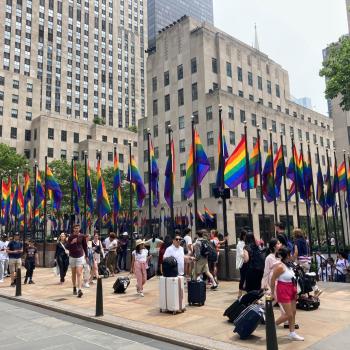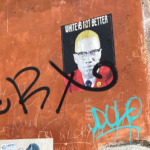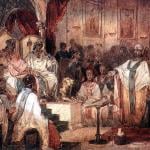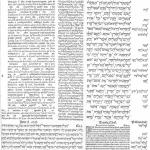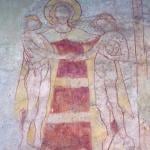
Just days after publishing an article about ethnic identity and racial identity categories, I see this news story. LA mayoral candidate Rick Caruso, an American of Italian descent, made waves for claiming not to be “white.”
Moderating the debate on Tuesday night, the Telemundo journalist Dunia Elvir said: “And this question goes for the both of you. The next mayor of Los Angeles will be either an African American woman or a white man.”
“I’m Italian,” Caruso said.
“Italian American,” Elvir said, with a chuckle.
“Thank you, that’s Latin,” Caruso said.
The Guardian article proceeds to cite several reactions to the comments, including:
“White identity has always been elastic, and it certainly now includes white Italians such as Rick Caruso,” tweeted Jamil Smith, a writer for the Los Angeles Times.
“It isn’t so pliant that Italians should be equated to Latinas without common parentage. I can’t tell whether he was trying to pander to Latina voters, gaslight them, or both.”
Another user tweeted: “Europeans will correct you so fast for reducing their heritage to ‘white’. The very same people who created the concept of race!”
Another claimed: “I think this proves that it’s now to your political detriment to be white in LA. Terrible self-own for Californians who try to pass themselves off as the least racist in the country.”
In my article on Indigenous People’s Day and Columbus Day last week, I cited an exceptional 2019 NYTimes article by Brent Staples, who pointed out that the institution of Columbus Day in the late 1800s was less a celebration of Christopher Columbus and more so an attempt to elevate the status of Italians in the eyes of the WASP hegemon.
I insisted that
few Italian Americans realize that their legitimacy in the eyes of American society was built on two foundational myths: that Columbus was indeed an honorable and virtuous example of Italians’ contributions to the establishment of this nation, and that “whiteness” as a category exists. I perceive this tension still today when talking to my fellow Italian Americans. Most seek to distinguish themselves from what they consider the bland, genteel mannerisms of Anglos, while also distinguishing themselves from minorities considered to be “of color.”
It’s worth including here that many Italians who have negative sentiments toward POCs don’t realize how much their racism is rooted in an attempt to gain legitimacy in the racial hierarchy that was artificially constructed by Anglos. So much for making fun of the “merigans”—whose “game” we’ve acquiesced to playing.
Situations like the one that unfolded last week reveal that ethnic (or “spicy”) whites who claim not to be white (especially Italians, Spaniards, and Portuguese people who claim to be Latin), and people who insists that non-POCs are obligated to identify as “white,” are talking on two different planes. Until they come to terms with this, they are going to continue talking past each other.
The former camp is speaking about identity in terms of aesthetics: which more broadly includes culture, personality traits and temperament, social norms and traditions, metaphysical convictions and spiritual sensibilities. Being Italian, in this case, is certainly not the same as being of English, German, or Scandinavian descent…nor is it the same as being Puerto Rican or Mexican…though it has much more in common with Latin American cultures than it does with Anglo-Saxon ones. And technically, yes, Italians are Latin if the term includes all people who speak Romance languages (and who have ties to the cultural legacy of the Roman Empire).
The latter camp is speaking about identity in terms of political power, and generally relies on abstracted identity categories–following the cues of poststructuralist critical theorists–that group people based on disparities in power dynamics. In this case, both Italian and Latin@ (depending in part on their skin color and socioeconomic status) immigrants in the US faced oppression at the hands of the WASP establishment, though Italians generally had an easier time gaining power and financial security. This was due in part to their ability to pass more easily as “white” than did most Latin@s…especially more so than Afrolatin@s.
So was Caruso “wrong” for claiming not to be white and for claiming to be Latin? It depends on how you look at it. Surely he can’t be blamed for distinguishing himself from WASPs–whom he differs from both culturally and in terms of “privilege.” And surely we can argue that it is presumptuous of anyone to claim to have the authority to assign him an identity that (a) he doesn’t relate to and (b) erases his cultural heritage.
The cognitive dissonance of those who advocate for the agency of individuals to determine their own gender identity but not their own racial or ethnic identity is astounding. Furthermore, it’s strange that Italian-Americans are ascribed the same guilt as slave owning and colonizing whites, when their ancestors didn’t own slaves in the US nor did they possess any colonies (unless you include their failed attempts in Ethiopia and Libya).
On the other hand is the denial of non-POCs, especially Italians, of their own privileges and the systemic oppression of enslaved and colonized people. Surely Italians faced prejudice from WASPs when they came here. But the fact is that Italians came to the US freely and not as slaves, and had an easier time assimilating and working their way up the socioeconomic hierarchy than Latin@s of color. Italian-Americans (who know what it’s like to struggle and face discrimination) should be standing in solidarity with those less privileged than themselves, rather than priding themselves on their perceived “superiority.”
In a society where nuance is hard to come by, it is of utmost importance that we acknowledge that there are different levels or planes of discourse, and that two things can be true at the same time. We would be naive, however, to ignore that the power-focused discourse of poststructuralist thought currently has a monopoly in the universities, government, and corporate world. Furthermore, most proponents of poststructuralist-flavored social justice activism regard poststructuralism as a totalizing worldview–a religion of sorts–to the point that it recognizes no other facts or truths beyond its narrow, materialistic vision of dialectical power struggles.
In her first collection of essays, Camille Paglia comments on her struggles as an “intensely” ethnic woman with strong metaphysical convictions and a passion for aesthetics in a determinedly drab, materialistic academic world. She writes that the focus on diversity in universities is hypocritical, as it claims to distance itself from the old WASP establishment but in reality is determined to deny ethnic particularity as a value in itself. Instead, it values surface level diversity–identity as an abstraction–rather than celebrating the cultures, traditions, and beliefs of actual ethnic groups. “They want to talk about various ethnic groups [but] want to deny there’s any difference between [them]. This is insane! It’s illogical. It’s incoherent…The amnesiac liberal establishment wants to draw lines and erase all our mental life within those lines.”
“So what’s the answer to that? Be ethnic!” she exclaims. She goes on to express how as someone who is “very Italian…so Italian that it has crippled my advance in academe,” she noticed that the only people who understood her temperament in academia were New York Jews, who didn’t acquiesce to the “decorous,” “passionless,” “walking-on-egg-shells” WASP style of communication. She also acknowledges that her ethnic flair has enabled her to connect with her arts students, most of whom are Blacks and Hispanics from the inner city, precisely because she doesn’t rely on poststructuralist discourses of power, which “can never admit that aesthetics exist” and that “perfects the WASP alienation of mind and culture from emotion.”
She then highlights the similarities between Mediterranean and Hispanic spirituality and religious art. The gory crucifixes found in Mexican and Spanish churches, the elaborate public processions in Italy and Peru, reveal their shared aesthetic, cultural, and metaphysical sensibilities.
I felt this strongly while attending the feast of St. Gerard in Newark, New Jersey this past weekend. A tradition initiated by Italian immigrants nearly 125 years ago, the celebration–which includes food, music, games, prayer, Mass, and an extravagant procession of the saint’s statue to which devotees pin dollar bills–is a view into the complex, multilayered relationship between POCs and ethnic whites. Most of the city’s Italian immigrants were poor and discriminated against, until they were able to save up enough money to reach financial stability. After the influx of black Americans from the South in the 1930s and the race “riots” in the 1960s, nearly all of the Italians ran off to the suburbs, returning to Newark seldomly for celebrations like the feast of St. Gerard.
St. Lucy’s parish (who hosts the feast) is now largely Ecuadorian, Haitian, and Nigerian. One can see during moments like the feast the shared aesthetic and spiritual sensibilities of Italians and other immigrant groups of color. The devotion to the “white” saint transcends ethnic and racial divides. But one can also sense the division in a more material sense: the Italians are at times reluctant to include the parishioners of color in the celebration. Most of the vendors are Italian. It’s worth noting that as the years have gone by, I have seen Ecuadorian food trucks appear, and Nigerians participating more visibly in directing the procession.
For more on these topics, check out:
-Michael Novak’s The Rise of the Unmeltable Ethnics, which I cited heavily in my AmCon article. He has a lot to say about the erasure of ethnicity. The second edition (which was published after he became a neoconservative and “baptized” capitalism) includes a preface that explores the anti-ethnic bent of “diversity and multiculturalism,” and–like Paglia–accuses it of imposing a WASP worldview onto POCs and other ethnic groups.
-My interview with Albert Thompson, whose understanding of racial justice holds a space for ethnic identity rather than collapsing it into abstract categories based on power dynamics.
-My articles on Obianuju Ekeocha and Chris Arnade, which explore how poststructuralist critical theory can at times be used as a tool for ideological colonization of oppressed minority groups, precisely because of its rejection of their aesthetic and metaphysical convictions.
-My interviews with Katherine Dee (defaultfriend) and Bill Melone on ethnic erasure and transracialism, and Bill’s article on Rachel Dolezal in Mere Orthodoxy.
-My article on my grandfather’s work with Fr. Geno Baroni to unite ethnic whites and POCs in Newark.
-Lastly, I’d recommend films like My Big Fat Greek Wedding and Good Will Hunting and books like The Light in the Piazza that highlight the aesthetic distinctions between ethnic whites and WASPs, and films like Do the Right Thing that highlight the difference of power dynamics between ethnic whites and POCs.
$upport CracksInPomo by choosing a paid subscription of this page, or by offering a donation through Anchor. Check out my podcast on Anchor and YouTube and follow me on Instagram and Twitter.



